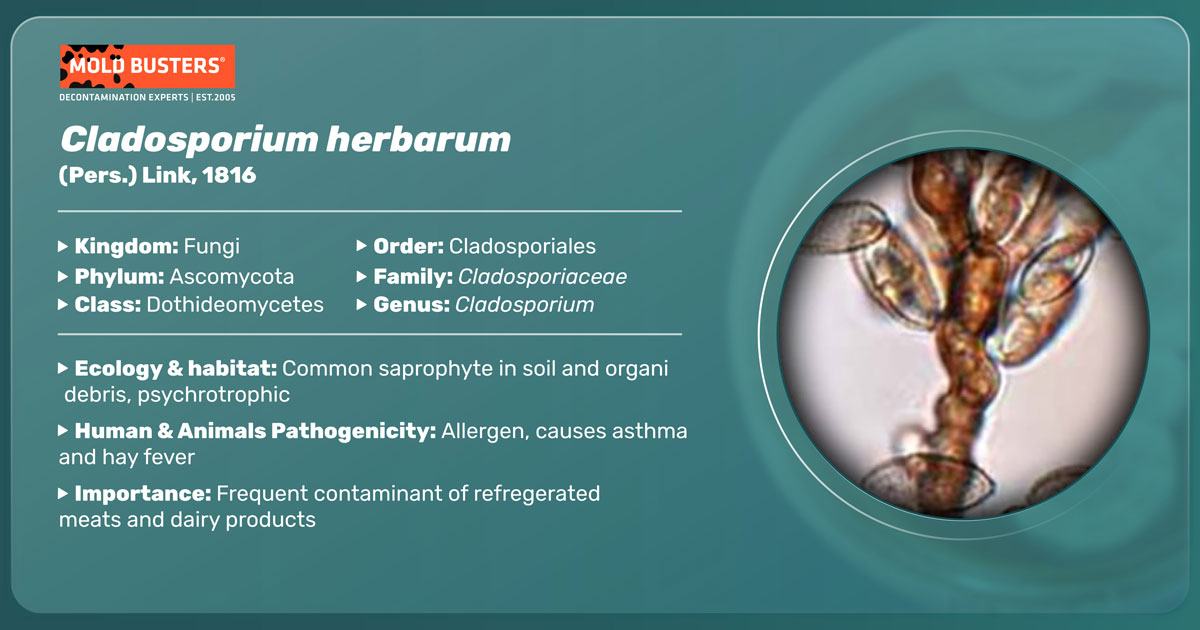(Pers.) Link, 1816
What is Cladosporium herbarum?
Cladosporium herbarum is a mold belonging to the genus Cladosporium, and it is one of the most commonly found fungi, both indoors and outdoors. Much like other Cladosporium species, C. herbarum is cosmopolitan in distribution, which means it can be found both indoors and outdoors, all over the world, on leaves of different types of plants, food, textiles, leather, paint, and various other forms of decaying organic matter, as well as in the soil [1,2].
Cladosporium species are a part of the dematiaceous (or pigmented) group of fungi, which produce melanin pigment in their cell walls. Because of this, the color of their colonies is dark and varies from light brown to olive-brown or black. Cladosporium herbarum colonies are usually pale brown to dark brown. Their colonies grow rapidly and are velvety or cottony in texture and appearance [3, 4]. Due to their color, when found on the surface of plants that they frequently inhabit, they are often referred to as “sooty mold” in horticulture [5]. Cladosporium herbarum is known to cause black points on wheat and other cereals [6].

Where can be Cladosporium herbarum found?
Cladosporium herbarum has been identified as one of the most common molds in air samples taken from homes in Canada and the USA [7]. This mold can often be found in kitchens, bathrooms, and other humid rooms, such as basements, since the minimal required air humidity for its growth is 85-86%, while the ideal humidity is 95-96% [8]. Some Cladosporium species can grow on stone surfaces, concrete, bricks, and even rubber or insulation materials [9]. They can also be found on wooden furniture or other wooden surfaces and walls and wallpaper as secondary colonizers after Penicillium species and Aspergillus versicolor [8]. Although Cladosporium species optimally grow in the temperature range of 20-30 °C [10], C. herbarum has been isolated from frozen meat, which indicates that this mold can survive temperatures below 0 °C [8].
Furthermore, Cladosporium species, primarily C. herbarum and C. cladosporioides, have been known to colonize books in libraries and cause biodeterioration. In general, these fungi do not pose a threat to avid book readers, book collectors, and librarians; however, if the books are stored inappropriately for a longer period, in dark, humid rooms with inadequate airflow, these molds might develop and lead to allergies [11].
What are Cladosporium herbarum health effects?
Cladosporium herbarum is one of the most frequent aeroallergens, next to Alternaria alternata, and can often cause allergic rhinitis and asthma if the spores are inhaled. In rare cases, it can lead to other, more serious opportunistic infections in people with compromised immune systems [12]. These infections caused by Cladosporium species are mainly chromoblastomycosis, a chronic skin infection that causes scaly papules and nodules, which might evolve to ulcers over time if not treated, and phaeohyphomycosis, an infection of the skin or internal organs caused by dematiaceous (pigmented) fungi [6,13]. Of course, it is good to keep in mind that these infections rarely occur, primarily in immuno-compromised people. Exposure to Cladosporium molds is much more likely to manifest as rhinitis or asthma.
Cladosporium herbarum symptoms and diagnosis
Cladosporium herbarum and other Cladosporium species have been linked to increased risk of allergic sensitization and development of allergic rhinitis, asthma, rhinoconjunctivitis, and allergic alveolitis [12, 14]. These conditions can develop due to exposure to fungal spores, vegetative cells, or fungal metabolites [15]. Of course, not every person will react the same in exposure to these molds. It depends on their body’s sensitivity to the allergens produced by the mold, which might be linked to a person’s genetic predisposition for developing an allergic reaction [12, 14, 15]. These conditions are especially common in children who display immune hypersensitivity, which can more simply be described as an over-reaction of the immune system. The most common symptoms are sneezing, a runny or stuffy nose, itching of the skin or eyes, shortness of breath, and headaches.
Allergies to Cladosporium molds can be diagnosed with skin prick tests or by evaluating IgE levels, a type of antibody (immunoglobulin E) that is excessively produced in the body as a response to allergens [14, 15, 16].
So far, the main allergens of C. herbarum have been identified as proteins Cla h 1 and Cla h 2 and the enzyme enolase. While allergens Cla h 1 and Cla h 2 are linked explicitly to C. herbarum, the enzyme enolase is a highly conserved enzyme with an essential role in glycolysis. It is a known allergen of Saccharomyces cerevisiae or yeast, Candida albicans, and numerous other fungal species [17].
How to treat Cladosporium herbarum?
As with all allergens, the first recommended step in allergy prevention and treatment is avoidance of said allergens. Nevertheless, since these molds are so widespread and the concentration of their spores can be relatively high in outdoor environments, altogether avoiding contact might prove impossible. However, indoor exposure to C. herbarum can be brought under control or even entirely mediated by improving indoor air quality in houses or apartments [14] and hiring mold removal and decontamination experts, who will professionally remove fungi from your home to ensure healthy living conditions.
If you suspect an allergy to C. herbarum, since the intensity of the allergic reactions and the symptoms can significantly vary from person to person, depending on their immune system reaction and the intensity of the exposure to the fungi, it is highly recommended to consult a doctor for a proper diagnosis and the most proper medical treatment.

Did you know?
The #1 toxic mold type found in kitchens in Canada is the Penicillium/Aspergillus mold group?! Find out more exciting mold stats and facts on our mold statistics page.
References
- Schubert, K., Groenewald, J. Z., Braun, U., Dijksterhuis, J., Starink, M., Hill, C. F., … & Crous, P. W. (2007). Biodiversity in the Cladosporium herbarum complex (Davidiellaceae, Capnodiales), with standardization of methods for Cladosporium taxonomy and diagnostics. Studies in Mycology, 58, 105-156.
- Bensch, K., Braun, U., Groenewald, J. Z., & Crous, P. W. (2012). The genus Cladosporium. Studies in mycology, 72, 1-401.
- Howard, D. H. (2002). Pathogenic fungi in humans and animals. Pathogenic fungi in humans and animals., (Ed. 2).
- Rossmann, S. N., Cernoch, P. L., & Davis, J. R. (1996). Dematiaceous fungi are an increasing cause of human disease. Clinical Infectious Diseases, 22(1), 73-80. rhs.org.uk
- Ogórek, R., Lejman, A., Pusz, W., Miłuch, A., & Miodyńska, P. (2012). Characteristics and taxonomy of Cladosporium fungi. Mikologia lekarska, 19(2), 80-85.
- Fradkin, A. R. S. S. M. M. D., Tobin, R. S., Tarlo, S. M., Tucic-Porretta, M., & Malloch, D. (1987). Species identification of airborne molds and its significance for the detection of indoor pollution. Japca, 37(1), 51-53.
- Piecková, E., & Jesenská, Z. (1999). Microscopic fungi in dwellings and their health implications in humans. Annals of Agricultural and Environmental Medicine, 6(1), 1-12.
- Gutarowska, B. (2014). Moulds in biodeterioration of technical materials. Acta Universitatis Lodziensis. Folia Biologica et Oecologica, 10, 27-39.
- Aihara, M., Tanaka, T., Ohta, T., & Takatori, K. (2002). Effect of temperature and water activity on the growth of Cladosporium sphaerospermum and Cladosporium cladosporioides. Biocontrol Science, 7(3), 193-196.
- Zielińska-Jankiewicz, K., Kozajda, A., Piotrowska, M., & Szadkowska-Stańczyk, I. (2008). Microbiological contamination with moulds in work environment in libraries and archive storage facilities. Annals of Agricultural and Environmental Medicine, 15(1), 71-78.
- Weryszko-Chmielewska, E., Kasprzyk, I., Nowak, M., Sulborska, A., Kaczmarek, J., Szymanska, A., … & Jedryczka, M. (2018). Health hazards related to conidia of Cladosporium—biological air pollutants in Poland, central Europe. Journal of environmental sciences, 65, 271-281.
- Antunes, J., Pacheco, D., Sequeira, H., Marques, M., Filipe, P., & Travassos, R. (2012). Phaeohyphomycosis of the face, caused by Cladosporium sphaerospermum, in an immunocompetent child. Journal of the American Academy of Dermatology, 66(4).
- Viegas, C., Pinheiro, A. C., Sabino, R., Viegas, S., Brandão, J., & Veríssimo, C. (Eds.). (2015). Environmental mycology in public health: fungi and mycotoxins risk assessment and management. Academic Press.
- Kurup, V. P., Banerjee, B., Kelly, K. J., & Fink, J. N. (2000). Molecular biology and immunology of fungal allergens. Indian Journal of Clinical Biochemistry, 15(1), 31-42.
- Burton, O. T., & Oettgen, H. C. (2011). Beyond immediate hypersensitivity: evolving roles for IgE antibodies in immune homeostasis and allergic diseases. Immunological reviews, 242(1), 128-143.
- Breitenbach, M., Crameri, R., & Lehrer, S. B. (Eds.). (2002). Fungal allergy and pathogenicity(Vol. 81). Karger Medical and Scientific Publishers.
- Figure featured image. The genus Cladosporium – Scientific Figure on researchgate.net [accessed 29 Jul, 2021]

Get Special Gift: Industry-Standard Mold Removal Guidelines
Download the industry-standard guidelines that Mold Busters use in their own mold removal services, including news, tips and special offers:

Written by:
Ema Zivkovic
Mycologist
Mold Busters
Edited by:
Dusan Sadikovic
Mycologist – MSc, PhD
Mold Busters
